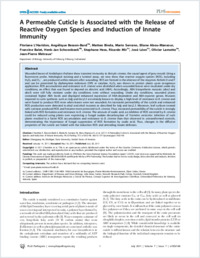A permeable cuticle is associated with the release of reactive oxygen species and induction of innate immunity
- L'Haridon, Floriane Department of Biology, University of Fribourg, Switzerland
- Besson-Bard, Angélique Department of Biology, University of Fribourg, Switzerland - UMR CNRS 5184 INRA 1088 Université de Bourgogne, Plante-Microbe-Environnement, Dijon, France
- Binda, Matteo Department of Biology, University of Fribourg, Switzerland
- Serrano, Mario Department of Biology, University of Fribourg, Switzerland
- Abou-Mansour, Eliane Department of Biology, University of Fribourg, Switzerland
- Balet, Francine Department of Biology, University of Fribourg, Switzerland
- Schoonbeek, Henk-jan Department of Biology, University of Fribourg, Switzerland - Department of Disease and Stress Biology, John Innes Center, Norwich Research Park, Colney, Norwich, United Kingdom
- Hess, Stephane Department of Biology, University of Fribourg, Switzerland
- Mir, Ricardo Department of Biology, University of Fribourg, Switzerland - Instituto de Biologia Molecular y Celular de Plantas, Consejo Superior de Investigaciones Cientificas, Universidad Politecnica de Valencia, Spain
- León, José Department of Biology, University of Fribourg, Switzerland - Instituto de Biologia Molecular y Celular de Plantas, Consejo Superior de Investigaciones Cientificas, Universidad Politecnica de Valencia, Spain
- Lamotte, Olivier Department of Biology, University of Fribourg, Switzerland - UMR CNRS 5184 INRA 1088 Université de Bourgogne, Plante-Microbe-Environnement, Dijon, France
- Métraux, Jean-Pierre Department of Biology, University of Fribourg, Switzerland
-
28.07.2011
Published in:
- PLoS Pathogens. - 2011, vol. 7, no. 7, p. e1002148
English
This study provides an explanation for the strong resistance to B. cinerea observed in wounded plants or plants with cuticular defects. We have observed that a production of ROS and a permeable cuticle is common to all these situations. ROS, that include hydrogen peroxide, are known inducers of resistance and can also act directly against the invading fungus. Degradation of the cuticle by exposure to cutinase also results in the production of ROS and resistance. These observations lead to a model where the cuticle plays a central role as a barrier against water-soluble elicitors from the surface. Under normal circumstances, the cuticle does not allow the passage of elicitors and no responses are induced. Under conditions where the cuticular barrier is broken, ROS and resistance are induced. This illustrates why plants that are in fact permanently exposed to potential elicitors do not constantly induce immune responses: this only takes place once the cuticle has been permeabilized, for example after an infection with a pathogen. This study also demonstrates how a cuticle-degrading pathogen avoids the generation of ROS by producing an effector that interferes with ROS production. Removal of this effector restores both ROS and resistance.
- Faculty
- Faculté des sciences et de médecine
- Department
- Département de Biologie
- Language
-
- English
- Classification
- Biological sciences
- License
- License undefined
- Identifiers
-
- RERO DOC 24851
- DOI 10.1371/journal.ppat.1002148
- Persistent URL
- https://folia.unifr.ch/unifr/documents/302125
Statistics
Document views: 97
File downloads:
- met_pca.pdf: 213
